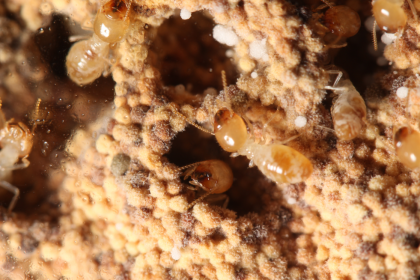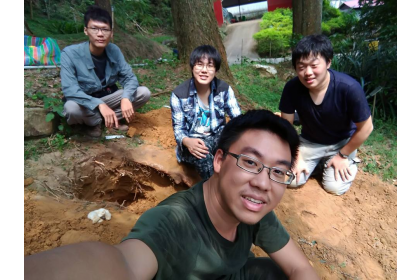Breakthrough in the key mechanism in the symbiosis of termites and fungi— NCHU's very own research published in top international journal
2019-10-23 16:43:10
興新聞張貼者
Unit秘書室
2,967
The Department of Entomology and the Department of Plant Pathology at National Chung Hsing University worked together for a breakthrough in the key mechanism of the symbiotic relationship between termites and fungi. The research results have been published in top international journal Fungal Ecology in June. The study found that fungi concentrate precious nutrients that termites are unable to produce on their own in spores. When feeding on these spores, termites not only receive the nutrients that they need, they also help the fungi disseminate spores. By examining a large number of samples, the key chemical components of this symbiotic mechanism are analyzed and are expected to be applied to termite control as a new bait to attract termites.
Dr. Chun-I Chiu of the Department of Entomology and Dr. Jie-Hao Ou of the Department of Plant Pathology at NCHU have invested four years into the research. The research subject of the paper is Odontotermes formosanus, which is the only termite species in Taiwan that lives symbiotically with fungi. First, the termites breakdown the collected wood and then build a matrix for planting the fungi, commonly referred to as the fungus garden. Because of this agricultural behavior, this type of termite is also called fungus-growing termite. The fungi planted by O. formosanus is called Termitomyces eurhizus, which grows out of the fungus garden in the ground at a certain time, producing a white body with a delicious, refreshing taste and a mouthfeel like chicken, hence it is also known as jizong mushroom. T. eurhizus grows in the form of hyphae in the fungus garden and also grows white, spherical-shaped fungal nodules, each containing numerous fungal spores. According to the experiment's observations, O. formosanus prefer to feed on these fungal nodules.
Dr. Chiu stated that although previous studies acknowledged termites prefer to feed on fungal nodules, there has not been a proper explanation; through their research, it is found that fungal nodules contain several essential amino acids that termites need. These ingredients with a high nutritional value are not found in fungus gardens and hyphae. This finding is direct evidence of how fungi effectively extend their lifespan, similar to how plants develop pulp that is full of sugar to entice animals to spread their seeds as they feed. In tropical and subtropical areas, fungus-growing termites are a serious economic pest. At present, there is a lack of an effective and attractive bait in pest control. The new discovery of these key elements needed by termites is expected to be applied in development of new termite baits—a big step forward for the field of pest control.
Dr. Ou specializes in mycology. Dr. Chiu stated that he has been working with Ou for four years. The two often collect termites, dig termite nests, and search for jizong mushrooms together while discussing the related mechanism. The co-published paper is the fruition of their long-term mutual learning and teaching and brainstorming.
Associate Professor Hou-Feng Li, advisor of Chiu's PhD studies, is an expert in termites and is also the corresponding author of the paper. Professor Li expresses affirmation for Chiu's research capabilities and hard work. Professor Li mentioned that the study mainly examined the chemical composition of the fungus garden, the fungal nodule, and that of termites. In order to collect enough termites for analysis, the laboratory invested a large amount of manpower and time. The minimum required weight to analyze the chemical composition of termites is 300g while the minimum required weight to analyze the chemical composition of fungal nodules is 3g, meaning that more than 100,000 individual termites and 120,000 fungal nodules need to be collected. Each fungal nodule is less than 1mm in size. At the time, Dr. Chiu and other students from the laboratory worked tirelessly to collect fungal nodules. Guan-Zhi Guan, a student responsible for collecting termites, stated that in order to gather 300g of termites, he and his laboratory colleagues spent three months holding a hand-held vacuum and separation device, "sucking" the termites foraging on trees.
Dr. Chun-I Chiu of the Department of Entomology and Dr. Jie-Hao Ou of the Department of Plant Pathology at NCHU have invested four years into the research. The research subject of the paper is Odontotermes formosanus, which is the only termite species in Taiwan that lives symbiotically with fungi. First, the termites breakdown the collected wood and then build a matrix for planting the fungi, commonly referred to as the fungus garden. Because of this agricultural behavior, this type of termite is also called fungus-growing termite. The fungi planted by O. formosanus is called Termitomyces eurhizus, which grows out of the fungus garden in the ground at a certain time, producing a white body with a delicious, refreshing taste and a mouthfeel like chicken, hence it is also known as jizong mushroom. T. eurhizus grows in the form of hyphae in the fungus garden and also grows white, spherical-shaped fungal nodules, each containing numerous fungal spores. According to the experiment's observations, O. formosanus prefer to feed on these fungal nodules.
Dr. Chiu stated that although previous studies acknowledged termites prefer to feed on fungal nodules, there has not been a proper explanation; through their research, it is found that fungal nodules contain several essential amino acids that termites need. These ingredients with a high nutritional value are not found in fungus gardens and hyphae. This finding is direct evidence of how fungi effectively extend their lifespan, similar to how plants develop pulp that is full of sugar to entice animals to spread their seeds as they feed. In tropical and subtropical areas, fungus-growing termites are a serious economic pest. At present, there is a lack of an effective and attractive bait in pest control. The new discovery of these key elements needed by termites is expected to be applied in development of new termite baits—a big step forward for the field of pest control.
Dr. Ou specializes in mycology. Dr. Chiu stated that he has been working with Ou for four years. The two often collect termites, dig termite nests, and search for jizong mushrooms together while discussing the related mechanism. The co-published paper is the fruition of their long-term mutual learning and teaching and brainstorming.
Associate Professor Hou-Feng Li, advisor of Chiu's PhD studies, is an expert in termites and is also the corresponding author of the paper. Professor Li expresses affirmation for Chiu's research capabilities and hard work. Professor Li mentioned that the study mainly examined the chemical composition of the fungus garden, the fungal nodule, and that of termites. In order to collect enough termites for analysis, the laboratory invested a large amount of manpower and time. The minimum required weight to analyze the chemical composition of termites is 300g while the minimum required weight to analyze the chemical composition of fungal nodules is 3g, meaning that more than 100,000 individual termites and 120,000 fungal nodules need to be collected. Each fungal nodule is less than 1mm in size. At the time, Dr. Chiu and other students from the laboratory worked tirelessly to collect fungal nodules. Guan-Zhi Guan, a student responsible for collecting termites, stated that in order to gather 300g of termites, he and his laboratory colleagues spent three months holding a hand-held vacuum and separation device, "sucking" the termites foraging on trees.



